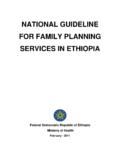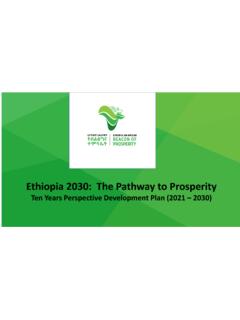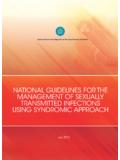Transcription of Federal Ministry of Health - Ethiopia Population, …
1 Federal Ministry of Health Health Management Information System (HMIS) / Monitoring and Evaluation (M&E) Strategic Plan for Ethiopian Health Sector HMIS Reform Team January 2008 Note to the reader: This draft of the HMIS / M&E awaits the human resource strategy; HMIS HR strategy is being prepared by Tulane University in Ethiopia (TUTAPE). It will be incorporated into this broader strategy paper after completion and approval by the relevant authorities. Introduction The Health Management Information System / Monitoring and Evaluation (HMIS/M&E) strategy fits within the objectives and priorities set by the Health Sector Development Program s (HSDPIII) strategic plan. The HSDPIII strategic plan itself responds to the objectives and priorities of national organizations, of regional, woreda, and kebele decentralized authorities, to the Health needs of the Ethiopian population, and to international agreements.
2 Similarly, the HMIS/M&E strategy must take account of these national, local, and international requirements, as well as those of the Health sector itself. In the national context, Ethiopia has implemented a multisectoral Plan for Accelerated and Sustained Development to End Poverty (PASDEP), with specific goals related to Health . The HSDPIII strategic plan responds to these national priorities and includes detailed national objectives to improve Health status through strengthening Health services and healthy behaviour. With the decentralization of responsibility for public sector services to regions and woredas, elected Assemblies at these administrative levels have authority to allocate the financial resources and mobilize community support for Health services. The Health sector, in turn, is accountable to regions, woredas, kebeles, and civil society in general for achieving performance improvements with these resources.
3 In the international context, Ethiopia , along with 188 other countries, has signed the declaration to achieve the Millennium Development Goals (MDGs), including the goals related to Health , by 2015. Many of these countries, including Ethiopia , have also signed additional World Health Organization (WHO) and United Nations (UN) conventions for monitoring and reporting progress towards goals within the Health sector and for eradication, elimination, control, and surveillance of specific diseases. Recognizing the importance of harmonizing the national, local, and international efforts for ongoing improvement of the Health of the population, the principle of having a single common plan, budget, and monitoring and evaluation system is a cornerstone of HSDPIII. A similar principle, called the Three Ones , has been formally adopted by UNAIDS; it is also a de facto operating principle for many other international initiatives.
4 The HMIS/M&E strategic plan aims to establish this single shared monitoring and evaluation system in Ethiopia . i Executive Summary The Government of Ethiopia (GOE) has guided all public sectors towards results-oriented management, emphasizing evidence-based decision making directed towards performance improvement. GOE has introduced Strategic Planning and Management (SPM) tools at all levels and recommended the use of Business Process Reengineering (BPR) to streamline operations. In accord with these principles and practices the Federal Ministry of Health (FMOH) has integrated SPM into its procedures and is reengineering the Ministry itself using BPR methodology. FMOH bases its activities on the implementation framework of the Health Sector Development Program (HSDP), which has had three successive strategic plans. Each of these plans has identified strengthening Monitoring and Evaluation / Health Management Information System (HMIS/M&E) as a key strategy for successful implementation.
5 Information quality and use remain weak within the Health sector, particularly at the peripheral levels of woreda and facility, which have primary responsibility for operational management under the woreda decentralization process begun in 2002 GC. Institutional will and guidance to correct this situation are strong and clear: improve information use in internal management and improve the quality of information to support improved management and to enhance credibility in reporting to external agencies. This strategic plan is based on the principles and objectives of PASDEP, HSDPIII, and national and international best practices. It employs the methodologies embedded in SPM and BPR and observes internationally recognized technical criteria for HMIS/M&E performance. Five strategic issues have been identified as critical to strengthen and continuously improve Health sector HMIS/M&E.
6 Capacity building. An effective HMIS/M&E requires an institutional structure that has appropriate staffing patterns, filled by persons with appropriate skills to perform their tasks, at each level. The current HMIS/M&E core process is weak in terms of both staffing patterns, including formal assignment of staff with job descriptions and assigned tasks, and established training modalities for HMIS/M&E. Therefore, the first strategic issue addresses the need to institutionalize HMIS/M&E responsibilities in the staffing structure and to establish pre-service and in-service HMIS/M&E training. Standardized and integrated data collection and reporting. By definition, the HMIS collects data for performance monitoring from service delivery and administrative records. In Ethiopia , with the exception of some vertical programs, there are no standard instruments to collect information when clients and patients interact with care givers.
7 Like the service delivery instruments, there is little standardization of HMIS reporting forms. The consequence is that information from one location may not be comparable to that from another location. Standards that do exist are often determined by the needs of specific programs, whose information needs may in turn be driven by donor reporting requirements. In addition, there is little integration of the recording instruments for different services. The consequence is that the same information may be recorded several times, creating a large data burden, yet the care provider may lack essential information on other services provided. ii This situation is the opposite of the objective of the HMIS/M&E core process, which is to enhance local self-assessment for performance improvement, in the most efficient possible way. In order to harmonize the information needs of all HMIS consumers, a standardized set of indicators will be collected and reported, based on standardized forms, and reported through an integrated channel.
8 Linkage between information sources. The HMIS relies on data collected from several sources: service delivery, finance, human resources, logistics, and capital assets. To provide as complete a picture as possible of the Health sector, information from other governmental organizations and from the private for-profit and not-for-profit sectors should also be included. HMIS data should also be harmonized with Health -related and multisectoral data collected by other organizations, such as vital events registration, census, survey, etc. Providers of HMIS and other Health -related information need to establish common data definitions and understanding on how to interpret the information. Information use. Action-oriented performance monitoring. All of the HMIS/M&E reforms are directed towards supporting and strengthening local action-oriented performance monitoring.
9 This is the main objective of the HMIS/M&E core process. Accomplishing this objective requires a paradigm shift from simply reporting data and responding to the situation as instructed by higher authorities, to analyzing and interpreting the information, and self-assessment and problem-solving. Reorienting and redirecting Health workers at all levels of the system, from Health Post to FMOH, will require technical interventions to improve HMIS/M&E tools and methodologies; behavioural interventions to change Health workers attitudes towards their own capacities, their jobs, and their roles in the organization; and organizational interventions to change the organizational values and practices to value and exhibit evidence-based decision making. Appropriate technology. HMIS/M&E has not used information and communications technology (ICT) systematically to support data collection, transmission, analysis, or presentation.
10 Introduction of ICT, and an electronic HMIS at woreda/subcity, regional/zonal, and Federal levels, will considerably enhance the MOH s ability to transfer data quickly, accurately, and efficiently. In addition, use of ICT expands the range of data presentation and analysis options enormously. Given the current fragility of infrastructure and ICT support in peripheral areas, the HMIS/M&E system will first prove itself as a clean and reliable manual system that can be used as a fallback in case of ICT failures. The strategic plan details these strategic issues and their associated thematic areas. Seventeen objectives have been defined to address the major themes identified. Selected strategies have also been outlined, along with activities and metrics to measure their implementation. Implementation is scheduled for 2008-2010 GC.









